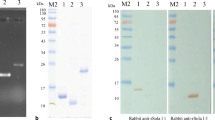Abstract
An evaluation of the potential allergenicity of different tomato ecotypes is reported. Twelve tomato ecotypes were assessed through a proteomic approach, using pools of sera of allergic patients from two different regions (Emilia Romagna in Northern Italy and Campania in Southern Italy), in order to identify the major allergens and evaluate differences in IgE binding properties of the tomato cultivars. Pooled sera of allergic people from Emilia Romagna showed as the main allergen a suberization-associated anionic peroxidase, whereas pooled sera of allergic patients from Campania were mostly reactive to profilin. The two proteins were identified through a proteomic approach based on the use of high-resolution mass spectrometric techniques. Quite interestingly, in some cases, several ecotypes showed a less reactivity toward patients’ sera than other, potentially indicating the possibility to identify ipoallergenic varieties. Anyway, the allergenic pattern response to tomatoes was serum-specific, indicating that the allergenic properties of different tomato ecotypes are defined by the specific proteins to which the patient is sensitized, a strong indication that ipoallergenicity of the different ecotypes is possible, but mostly related to the individual susceptibility.






Similar content being viewed by others
References
Sicherer SH, Sampson HA (2009) Food allergy: recent advances in pathophysiology and treatment. Ann Rev Med 60:261–277
COMMISSION DIRECTIVE 2007/68/EC of 27 November 2007 amending Annex IIIa to Directive 2000/13/EC of the European Parliament and of the Council as regards certain food ingredients (2007) Official Journal of the European Union. http://eur-lex.europa.eu
Osterballe M, Hansen TK, Mortz CG, Bindslev-Jensen C (2005) The clinical relevance of sensitization to pollen-related fruits and vegetables in unselected pollen-sensitized adults. Allergy 60:218–225
Vieths S, Scheurer S, Ballmer-Weber B (2002) Current understanding of cross-reactivity of food allergens and pollen. Ann NY Acad Sci 964:47–68
Ebner C, Hirschwehr R, Bauer L, Breiteneder H, Valenta R, Ebner H, Kraft D, Scheiner O (1995) Identification of allergens in fruits and vegetables: IgE cross-reactivities with the important birch pollen allergens Bet v 1 and Bet v 2 (birch profilin). J Allergy Clin Immunol 95:962–969
Westphal S, Kempf W, Foetisch K, Retzek M, Vieths S, Scheurer S (2004) Tomato profilin Lyc e 1: IgE cross-reactivity and allergenic potency. Allergy 59:526–532
De Martino M, Novembre E, Cozza G, De Marco A, Bonazza P, Vierucci A (1988) Sensitivity to tomato and peanut allergens in children monosensitized to grass pollen. Allergy 43:206–213
Beezhold DH, Sussman GL, Liss GM, Chang NS (1996) Latex allergy can induce clinical reactions to specific foods. Clin Exp Allergy 26:416–422
Westphal S, Kolarich D, Foetisch K, Lauer I, Altmann F, Conti A, Crespo JF, Rodrıguez J, Enrique E, Vieths S, Scheurer S (2003) Molecular characterization and allergenic activity of Lyc e 2 (b-fructofuranosidase), a glycosylated allergen of tomato. Eur J Biochem 270:1327–1337
Le LQ, Lorenz Y, Scheurer S, Fötisch K, Enrique E, Bartra J, Biemelt S, Vieths S, Sonnewald U (2006) Design of tomato fruits with reduced allergenicity by dsRNAi-mediated inhibition of ns-LTP (Lyc e 3) expression. Plant Biotechnol J 4:231–242
Kondo Y, Urisu A, Tokuda R (2001) Identification and characterization of the allergens in the tomato fruit. Int Arch Allergy Immunol 126:294–299
Asero R, Mistrello G, Roncarolo D, Amato S, Arcidiacono R, Fortunato D (2008) Detection of a novel allergen in raw tomato. J Investig Allergol Clin Immunol 18:397–400
Bassler OY, Weiss J, Wienkoop S, Lehmann K, Scheler C, Dolle S, Schwarz D, Franken P, George E, Worm M, Weckwerth W (2009) Evidence for novel tomato seed allergens: IgE-reactive legumin and vicilin proteins identified by multidimensional protein fractionation-mass spectrometry and in silico epitope modeling. J Proteome Res 8:1111–1122
Germini A, Paschke A, Marchelli R (2007) Preliminary studies on the effect of processing on the IgE reactivity of tomato products. J Sci Food Agric 87:660–667
Pravettoni V, Primavesi L, Farioli L, Brenna OV, Pompei C, Conti A, Scibilia J, Piantanida M, Mascheri A, Pastorello EA (2009) Tomato allergy: detection of IgE-binding lipid transfer proteins in tomato derivatives and in fresh tomato peel, pulp, and seeds. J Agric Food Chem 57:10749–10754
Le LQ, Mahler V, Lorenz Y, Scheurer S, Biemelt S, Vieths S, Sonnewald U (2006) Reduced allergenicity of tomato fruits harvested from Lyc e 1–silenced transgenic tomato plants. J Allergy Clin Immunol 118:1176–1183
Breiteneder H, Radauer C (2004) A classification of plant food allergens. J Allergy Clin Immunol 113:821–830
Kitagawa M, Moriyama T, Ito H, Ozasa S, Adachi A, Yasuda J, Ookura T, Inakuma T, Kasumi T, Ishiguro Y, Ito Y (2006) Reduction of allergenic proteins by the effect of the ripening inhibitor (rin) mutant gene in an F1 hybrid of the rin mutant tomato. Biosci Biotechnol Biochem 70:1227–1233
Monaci L, Visconti A (2009) Mass spectrometry-based proteomics methods for analysis of food allergens. Trends Anal Chem 28:581–591
Yagami T, Haishima Y, Tsuchiya T, Tomitaka-Yagami A, Kano H, Matsunaga K (2004) Proteomic analysis of putative latex allergens. Int Arch Allergy Immunol 135:3–11
Rao R, Corrado G, Bianchi M, Di Mauro A (2006) (GATA)4 DNA fingerprinting identifies morphologically characterized ‘San Marzano’ tomato plants. Plant Breed 125:173–176
Yu LX, Nasrallah J, Valenta R, Parthasarathy MV (1998) Molecular cloning and mRNA localization of tomato pollen profilin. Plant Mol Biol 36:699–707
Weangsripanaval T, Nomura N, Moriyama T, Ohta N, Ogawa T (2003) Identification of suberization-associated anionic peroxidase as a possible allergenic protein from tomato. Biosci Biotechnol Biochem 67:1299–1304
Gaffe J, Tieman DM, Handa A (1994) Pectin methylesterase isoforms in tomato. Plant Physiol 105:199–203
Carrington CMS, Vendrell M, Domınguez-Puigjaner E (2002) Characterisation of an endo-(1, 4)-b-mannanase (LeMAN4) expressed in ripening tomato fruit. Plant Sci 163:599–606
Author information
Authors and Affiliations
Corresponding author
Rights and permissions
About this article
Cite this article
Bencivenni, M., Faccini, A., Bottesini, C. et al. Assessing allergenicity of different tomato ecotypes by using pooled sera of allergic subjects: identification of the main allergens. Eur Food Res Technol 234, 405–414 (2012). https://doi.org/10.1007/s00217-011-1640-4
Received:
Revised:
Accepted:
Published:
Issue Date:
DOI: https://doi.org/10.1007/s00217-011-1640-4




